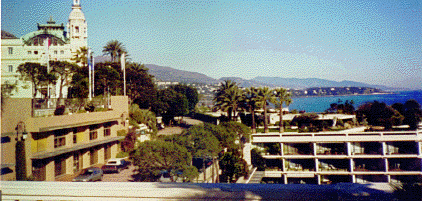Monaco

Culture
Monaco, small independent principality of Europe, forming an enclave
in southeastern France, bordered on the south by the Mediterranean Sea
and surrounded on the north, east, and west by the French department
of Alpes-Maritimes. The principality, which lies east of Nice, is a
famous resort. The country is 1.8 sq km (0.7 sq mi) in area. The
population (census 1982) was 27,063; the estimate for 1989 was
29,200. Monaco has one of the highest population densities of any
country in the world, 16,222 persons per sq km (41,714 per sq mi) in
1989. The principality is composed of four districts: Monaco, the
capital; La Condamine; Monte Carlo; and Fontvieille. The official
language of the country is French, although a number of people speak
Mongasque, a mixture of French and Italian. The commune of
Monaco, located on a rocky promontory, is an ancient fortified town.
Among its points of interest are a cathedral, a palace in the medieval and
Renaissance styles, and an oceanographical museum, established in
1910 by Prince Albert I (1848-1922). The Monte-Carlo Opera and
Monte-Carlo Philharmonic Orchestra are here; the Monaco Grand Prix
and Monte-Carlo Rally are popular annual automobile-racing events. (Encarta, Monaco)
Economy
The principal occupations in Monaco are connected with the tourist
trade, the economic foundation of the state. The sale of postage stamps
and tobacco, banking and insurance, and the manufacture of
pharmaceuticals, electronic equipment, cosmetics, and plastic goods are
also of economic importance. In the late 1980s annual budget figures
showed about $414 million in revenue, and expenditure of about $406
million. A major source of revenue is the great gambling casino at Monte
Carlo. Monaco's principal unit of currency is the French franc,
consisting of 100 centimes (5.728 francs equal U.S.$1; 1990). (Encarta, Monaco)
Government
A new constitution greatly reducing the power of the sovereign was
granted to the principality of Monaco by Prince Rainier III in 1962.
Legislative authority is shared by the Prince and the National Council of
18 members, elected by universal suffrage for 5-year terms. The
executive branch consists of the prince and a small Council of
Government headed by a minister of state who is traditionally French.
The leading political party is the National and Democratic Union. (Moore, 504)
History
In 1297 the principality was acquired by the house of Grimaldi, a
Genoese family. In 1793, during the French Revolution, the Grimaldi
were dispossessed and their principality was annexed by France. By the
terms of the Treaty of Vienna, in 1815, the principality was made a
protectorate of the kingdom of Sardinia. (Encarta, Monaco)
In 1861 Monaco was restored to its position as an independent state under the guardianship of France.
The principality was granted a constitution by Prince Albert I in 1911.
Impressions
Monaco and Monegasques
I had never imagined that the streets of a city could be lined with orange
trees full of oranges, but that abstract concept appeared as a reality to me
along the streets of Monaco. In the place that is famous for its car races
and gambling, I think I found a piece of paradise. It was in the lushness
of the flora, in the warm breeze that passed through there in the middle
of January, and in the glamorous existence that I imagine all
Monegasques as having. That is what the 4,000 citizens of the
principality of Monaco are known as, Monegasques. Those privileged
few are not required to pay taxes, yet they only have one square mile of
land to call their own, and even that is on the side of mountains which
plummet down into the sea. The sea there rivals the sky in its blueness,
and the appearance that the water of the bay was actually a pool of
sparkling marbles is what I will remember about the Mediterranean.
After all of the art that we saw in the major museums of France and
Italy, I remember Monaco as a piece of art that has been painted into
reality. The colors and exotic qualities could have easily been from a
painting, and the flamboyance of the people and places there could
convince me that I was actually dreaming of such a place. Yet the reality
of Monaco seems more artful than a painting of it could ever be.
-Nick Neises
Monaco and Wealth
At first glance, it seemed an oasis, a utopia. The lucky few citizens pay no taxes and enjoy all manner of perks and priveledge. The founders of Monaco could not have picked a more beautiful location in the area-and on the French Riviera, that's quite a statement. Monaco may be better spelled Moneyco. The amassed wealth flows out onto the streets and into every corner of the city giving it a sanitary look unseen elsewhere. Sports cars line the alleys and dapper-looking businessmen trot by. Gambling and tourism go hand in hand here. Our less-than-polished group felt just a little out of place among the glitz and glamour, but that didn't stop us from sticking our noses where we could.
-Ben Perry